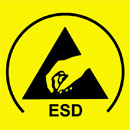ESD terms
ESD— Electrostatic discharge is the release of static electricity when two objects come into contact. Familiar examples of ESD include the shock we receive when we walk across a carpet and touch a metal doorknob and the static electricity we feel after drying clothes in a clothes dryer. A more extreme example of ESD is a lightning bolt. While most ESD events are harmless, it can be an expensive problem in many industrial environments.
ESDS — Electrostatic discharge sensitive (devices). Many electronic devices are susceptible to low voltage ESD events. For example, hard drive components are sensitive to only 10 volts. For this reason, manufacturers of electronic devices incorporate measures to prevent ESD events throughout the manufacturing, testing, shipping, and handling processes.
EPA — ESD protected area. ESD prevention within an EPA should involve ESD furniture and tools, appropriate ESD-safe packing material, the use of antistatic garments worn by assembly workers, conductive wrist straps and footwear to prevent high voltages from accumulating on workers' bodies, anti-static mats or conductive flooring materials to conduct harmful electric charges away from the work area, and humidity control. Humid conditions prevent electrostatic charge generation because the thin layer of moisture that accumulates on most surfaces serves to dissipate electric charges. Ion generators (ionizers) are sometimes used to inject ions into the ambient airstream.
The terms anti-static, conductive, and dissipative are all terms that subdivide ESD into more detail. Something insulative is not considered ESD safe.
Materials are divided into these terms based on their individual surface resistance. Surface resistance is a measurement of how easily an electric charge can travel across a medium. Conductive materials are materials that have a surface resistance of less than 1 x 10 5 ohms/square. Dissipative items have a surface resistance of more than 1 x 10 5 ohms/square but less than 1 x10 11 ohms/square.
Anti-static materials are generally referred to as any material which inhibits triboelectric charging. This kind of charging is the buildup of an electric charge by the rubbing or contact with another material. An insulative material is one that has a surface resistance of greater than 1 x 10 12 ohms/square.
Conductivity - the ratio of the current per unit area (current density) to the electric field in a material. Conductivity is expressed in units of siemens/meter. In non-technical usage, the ability to conduct current.
Conductive Material - material that has a surface resistivity less than 1 x 105 ohms/square or a volume resistivity less than 1 x 104 ohm-cm.
Static Dissipative - refers to the ability of a material to conduct a charge to ground and is usually indicated by an electrical resistance range measured in Ohms of a minimum of 1.0x 106, to a maximum of 1.0 x 109.
ESD signs are a must have in facilities that have areas that need to be static free. These zones require that proper static grounding equipment be used to ensure the safety of all those in the facility. Safety signs like static grounding signs in these areas can help workers stay informed of the static grounding policies.
Decay Time - the time required for an electrostatic potential to be reduced to a given percentage (usually 10%) of its initial value
Surface resistance - is the resistance of a surface measured by a concentric ring electrode test method defined in 61340-5-1and IEC 61340-2-3: 2000.
Point-to-point resistance - is the resistance measured between two electrodes placed on a surface, defined in 61340-5-1, IEC 61340-2-3: 2000.
Resistance-to-ground - is the electrical resistance measured from a point to the ESD facility electrical earth (usually mains power earth).
ESD Susceptibility Symbol
 The ESD Susceptibility Symbol, consists of a triangle, a reaching hand, and a slash through the reaching hand. The triangle means "caution" and the slash through the reaching hand means "Don't touch." Because of its broad usage, the hand in the triangle has become associated with ESD and the symbol literally translates to "ESD sensitive device, don't touch."
The ESD Susceptibility Symbol, consists of a triangle, a reaching hand, and a slash through the reaching hand. The triangle means "caution" and the slash through the reaching hand means "Don't touch." Because of its broad usage, the hand in the triangle has become associated with ESD and the symbol literally translates to "ESD sensitive device, don't touch."
The ESD Susceptibility Symbol is applied directly to integrated circuits, boards, and assemblies that are static sensitive. It indicates that handling or use of this item may result in damage from ESD if proper precautions are not taken. If desired, the sensitivity level of the item may be added to the label
ESD Protective Symbol

The ESD Protective Symbol, consists of the reaching hand in the triangle. An arc around the triangle replaces the slash. This "umbrella" means protection. The symbol indicates ESD protective material. It is applied to ESD furniture, mats, chairs, wrist straps, garments, packaging, and other items that provide ESD protection. It also may be used on equipment such as hand tools, conveyor belts, or automated handlers that is specially designed or modified to provide ESD control






